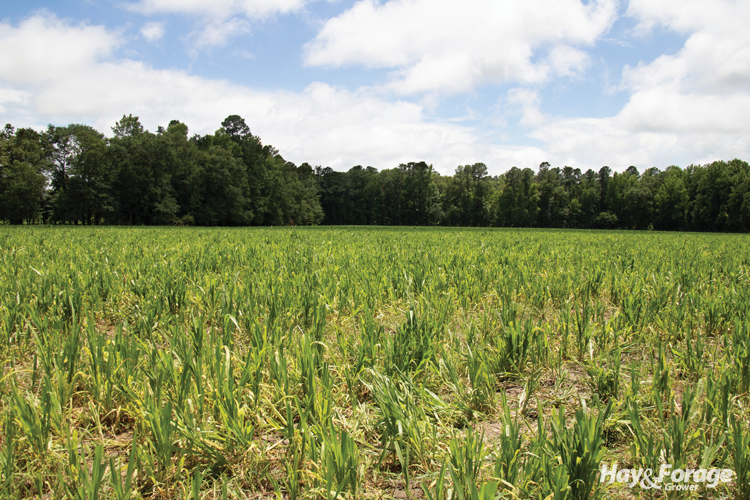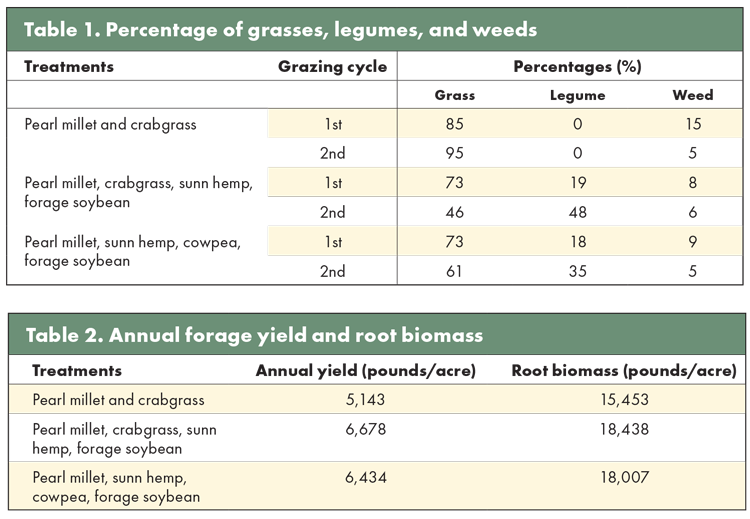Summer annuals enhance Southeastern pastures |
| By Liliane Silva |
|
|
The author is an extension forage specialist and assistant professor at Clemson University.  Avoid grazing summer annuals too low so that the growing points for regrowth are preserved and adequate leaf tissue remains. Warm-season annual forages are fast-growing, high-quality species that can supplement production and quality to support animal performance. In the Southeast, they are typically planted from April through June and can be managed for baleage production, greenchop, or grazing. Since most livestock operations in the region are based on perennial grasses, such as tall fescue and bermudagrass, summer annuals are good complementary forages. For example, these species can support nutritional requirements for stocker cattle during the summer months. Thus, due to their fast growth and stand establishment, summer annuals can help fill the gap of forage production for dormant tall fescue stands or on operations impacted by unfavorable weather conditions. Warm-season annual forages can be grown either in a monoculture or in mixtures. They require specific soil pH and fertility, and they need adequate site preparation ahead of planting. The most common annual warm-season grasses in the Southeast are crabgrass, pearl millet, sorghum, and sorghum-sudangrass. Crabgrass is highly productive, can be managed for reseeding at the end of the season, and can have a crude protein (CP) concentration around 15%. Pearl millet is high yielding with roughly 15% CP and has higher drought tolerance than sorghum and sorghum-sudangrass. Sorghum and sorghum-sudangrass are also high yielding with about 16% CP; however, they require proper grazing management to avoid issues with prussic acid poisoning or nitrate toxicity, mainly when drought or frost events occur. Sugarcane aphids can be an issue in these species as well, and if left uncontrolled, the pests will reduce forage yield and quality. Look to legumes With the rising costs of off-farm inputs and growing environmental concerns, the incorporation of legumes into grass stands can add organic nitrogen into the system while improving forage quality and soil fertility. Cowpea, sunn hemp, forage soybean, and hairy indigo are summer annual options for mixtures with grasses. When using forage mixtures, it is necessary to adjust seeding rates to allow the species to establish and grow well. These forage legumes can all have over 18% CP and can tolerate grazing, but rotational grazing will allow for more controlled forage removal and provide longer rest periods for plants to recover and regrow. Avoid overgrazing summer annual legumes to preserve the growing points of plants and maintain adequate leaf residual biomass for proper regrowth. For example, sunn hemp can be grazed around 45 to 60 days after planting when plants are 1 to 3 feet tall, whereas cowpea is low growing and requires different management to remain active during the growing season since its growing points are more vulnerable to overgrazing. Measure forage biomass to adjust the stocking rate and rotation length during the grazing season. A pasture ruler or grazing stick is recommended to determine forage height and estimate forage availability. On average, summer annual forage production ranges from 5,000 to 10,000 pounds per acre, depending on fertilization. Comparing combinations To assess the agronomic and environmental benefits of summer mixtures, an ongoing research trial is being conducted in South Carolina that includes a grass-only stand (pearl millet and crabgrass) and two grass-legume mixtures. Paddocks were planted in May 2023, and 50 pounds of nitrogen were applied per acre. Phosphorus and potassium were applied according to soil report recommendations, and no additional nitrogen was applied throughout the season. Due to weather conditions, grazing started in early July. These forage systems were managed under rotational grazing, and forage production and quality were determined, among other variables.  Preliminary results showed legume proportions in legume-containing mixtures doubled after the first grazing cycle (Table 1), which reflected greater forage production compared to the grass-only stand. The annual forage yields ranged from 5,140 to 6,670 pounds of dry matter per acre (Table 2), with 13% to 17% CP protein during the season. Researchers also assessed the root systems of these mixtures and found 15,450 to 18,440 pounds of roots per acre (Table 2). The root systems directly contribute to nutrient release and carbon supply into the soil when the plant biomass is decomposed. In this context, these contributions will support soil fertility and health improvement in the long term. Grazing guidelines Grazing management is crucial to keep the plants in the vegetative stage over time. Letting plants get overmature will cause higher trampling and waste of forage biomass and can shorten the growing season. Generally, due to changes in temperature and weather conditions, summer annual forages tend to play out in mid- to late September in the Southeast. Once the majority of the plants enter the reproductive stage and produce seedheads, overall forage production is compromised, and this signals the end of the grazing season. Proper grazing management is also critical during the season to promote adequate animal excreta distribution, especially in low nutrient input systems. The nutrients returned to the area will be recycled and used by the plants growing during the season but may also promote residual nutrient availability for the next crop in rotation. Warm-season annual mixtures may help provide more high-quality forage during summer months in the Southeast. These forage systems may alleviate reliance on off-farm inputs such as inorganic nitrogen fertilizer and feed supplementation to meet higher nutritional requirements of livestock. The incorporation of legumes into grass-based forage systems may also boost forage yield and quality, species diversity, stand resilience, and sustainability of forage-based livestock systems while enhancing soil health over time. Producers can contact their local extension agent or specialist to identify the best forage species and management practices to implement on their operation to achieve optimum results. This article appeared in the April/May 2024 issue of Hay & Forage Grower on pages 24-25. Not a subscriber? Click to get the print magazine. |
